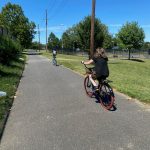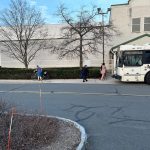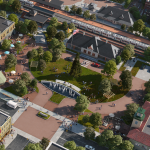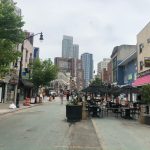New Jersey Future Blog
Unlocking Opportunities: Securing Funding for Trail-Related Projects
June 24th, 2024 by Zeke Weston
As the nation’s most densely populated state, New Jersey packs in more people per square mile than anywhere else. Our most vibrant cities and towns include compact, walkable downtowns and active streetscapes—complemented by accessible greenways and trails for recreation, a respite from urban life, and healthy, carbon-free travel. But being the Garden State, we can do so much more.
New Jerseyans enthusiastically support and want more greenways and trails. The public input process for the new draft Statewide Comprehensive Outdoor Recreation Plan (SCORP) included over 15,000 survey responses that identified hiking, walking, and gathering as top priorities, with trails highlighted as one of the most important outdoor amenities. Nonetheless, residents from the SCORP’s public focus groups mentioned several barriers to full participation in outdoor recreation, notably limited transportation options, whereby participants can comfortably travel to outdoor spaces. To overcome these barriers, towns and counties need to comprehensively plan and design trail projects that are safe, accessible, and well-connected. Most communities want to build outdoor recreation and active transportation facilities but lack the funding and resources to make them a reality.
Most communities want to build outdoor recreation and active transportation facilities but lack the funding and resources to make them a reality.
A panel titled “Connecting Communities to Capital for Greenways, Trails, and Bike Paths” addressed these issues and priorities at the 2024 NJ Planning and Redevelopment Conference (NJPRC), sponsored by New Jersey Future and the New Jersey chapter of the American Planning Association. Panelists brought a broad range of experiences to the discussion and an even greater depth of on-the-ground experience. They included: moderator Olivia Glenn, Chief of Staff and Senior Advisor for Equity, US EPA Region 2; Byron Nicholas, Chief, Division of Planning, Hudson County; Elizabeth Dragon, Assistant Commissioner, Community Investment and Economic Revitalization, NJ Department of Environmental Protection; Laine Rankin, Assistant Commissioner, Local Resources and Community Development, NJ Department of Transportation; and Teri Jover, Borough Administrator and Economic Development Director, Borough of Highland Park.
In her opening remarks, Olivia Glenn emphasized the importance of federal funding for state and local governments to invest in active transportation infrastructure, especially from the Inflation Reduction Act. She highlighted the $4 million awarded to New Jersey’s local, county, and state governments from the EPA’s Government to Government program last year. The funds will be used for government activities in partnership with Community-Based Organizations that result in measurable environmental and public health improvements in overburdened communities. One of the many types of projects the program can fund is urban greenways. Urban greenways provide access to nature and clean transportation corridors while simultaneously reducing the urban heat island effect. Because of their multifaceted benefits, Glenn emphasized the ability for trail-related projects, like urban greenways, to be funded by a wide variety of grant programs, not just transportation ones.
Teri Jover provided insight into how these types of projects come to fruition at the local level in a municipality. The Highland Park River Greenway was a dream of the Borough’s residents and elected officials for decades. In 2017, the Borough finally developed a one-page description of the Greenway to share with the county and state. At that time, Jover noted that the project needed to be fleshed out in more detail for it to advance. Because of Highland Park’s limited staff capacity and resources, she highlighted the Borough’s inability to afford a consultant despite needing one. Fortunately, Highland Park applied for and received a budgetary grant from the NJ Department of Community Affairs to conduct the feasibility studies and topographic surveys needed for the project, which was funded by a one-time earmark from the state legislature. This grant allowed the Borough to conduct the analysis and planning to push the project forward, but Jover acknowledged the need for additional money to construct and then maintain the Greenway. This will be a long-term project, as many greenways are, and, she emphasized the importance of staying committed to these projects until the end.

Byron Nicholas spoke to the regional perspective and process for advancing trail projects, drawing on his experience with various Greenways in Hudson County. Because Hudson County is the most densely populated county in the state, access to riverfronts and open spaces is limited despite the existence of the Hudson, Hackensack, and Passaic Rivers. Therefore, the county looked at how to improve access to outdoor amenities while providing alternate transportation options. This resulted in the 2022 Hackensack River Greenway plan. The County needed to develop a concept design for the Lincoln Park segment of the Hackensack River Greenway, so they applied for and received a grant of approximately $1.5 million from the Transportation Alternative Program (TAP). The TAP grant funded the preliminary and final designs of the Greenway and the beginning of construction. From this experience, Nicholas emphasized the importance of establishing and maintaining relationships with your project partners. He noted that their bi-monthly working group meetings were critical to the project’s success and should be a component of all regional trail projects.
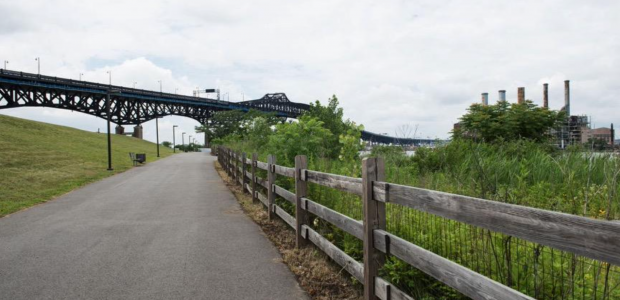
Hackensack River Greenway
Elizabeth Dragon emphasized the importance of intentional planning for successful trail projects. Effective trail planning includes research, community engagement, and alignment with state and local initiatives. When reviewing grant applications to the Green Acres Program, Dragon noted that the most competitive applications identify the project’s economic, environmental, and community benefits and demonstrate its positive impact on local business, tourism, environmental preservation, and social cohesion. She highlighted the importance of addressing the NJ Department of Environmental Protection’s triple bottom line in the grant application: economy, environment, and people. Connecting your trail or greenway project to these priorities and outcomes cannot be overstated. Similarly, Dragon noted the need to identify how the project complements local and state land use plans. The most successful applications are consistent with these plans and their priorities.
The most competitive grant applications highlight the project’s economic, environmental, and community benefits and identify its positive impact on local business, tourism, environmental preservation, and social cohesion.
Laine Rankin described the funding opportunities available at the NJ Department of Transportation for trail-related projects. She identified the state’s Bikeways Program and Municipal Aid Program as opportunities for towns and counties to access funding for such projects. Rankin made sure to note that the state’s programs are intended for shovel-ready projects that have already completed the planning and design phases. For example, Montgomery Township received a $360,000 Municipal Aid grant in 2020 to build 1.5 miles of bike lanes and 2.1 miles of new multi-use paths around Skillman Park. On the other hand, Federal programs for trail-related projects, like the Transportation Alternative Set-Aside (TASA), do not have the same shovel-ready requirements. For instance, Burlington County received a $440,000 TASA grant in 2020 to build a portion of the Delaware River Heritage Trail along the Route 130 bypass. Rankin reiterated the importance of knowing what project types each program funds so that towns apply to the most appropriate program for their needs.
Now, more than ever, New Jersey needs to meet its residents’ wants and needs for greenways and trails that provide equitable mobility and access to nature. The state’s municipalities and counties can make this a reality, but they need to know the appropriate funding programs to do so. Towns interested in trail-related projects should contact their County planning departments and Metropolitan Planning Organizations for further assistance and information.
Related Posts
Tags: 2024 NJ Planning and Redevelopment Conference, active transportation, bike, bike paths, greenways, New Jersey planning and redevelopment conference, outdoor recreation, outdoor spaces, Pedestrian, pedestrian accessibility, pedestrian safety, recreation, trails, walkable

